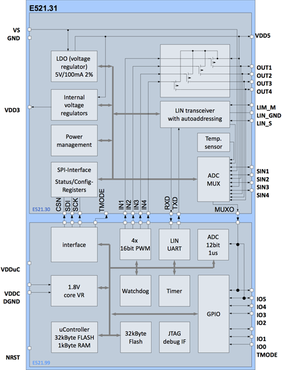Elmos: LIN controller with position detection

The chip is designed for automotive applications featuring a temperature range of -40 °C to +125 °C. For temperature compensation the semiconductor provides an integrated temperature sensor. The two flash memory blocks have a 32-KiB capacity each.
The LIN chip supports an auto-addressing function, which detects the position in the network
The chip supports auto-addressing, which allows LIN slaves to detect their relative position in the linear bus-system with daisy-chained devices. The hardware extensions needed for that purpose are a shunt resistor between nodes LIN_M and LIN_S, a pull-up current source of typically 2 mA, and a circuitry that makes it possible to measure the differential voltage over the shunt resistor.
The start of the addressing sequence is initialized by the ECU, with a command sent to the slaves telling them that the addressing sequence starts with the next break field. During the next break field each slave starts its sequence. The sequence is divided up in measuring the offset current on the bus line, measuring the busload and, depending on the busload, switching on the current source for the detection of the last not addressed slave in the line. It is recommended to use a 1-mA. This give the maximum noise immunity to the low value (0 mA) and the high value (2 mA if only one other slave is behind). In order to assure that all the slaves execute the different steps of the auto-addressing sequence synchronously, a timing scheme for the break field is defined. The time reference is the bit time tBIT,SLAVE.